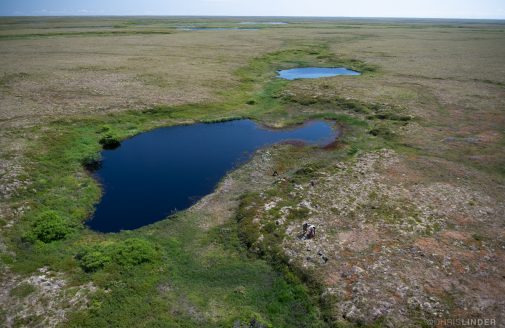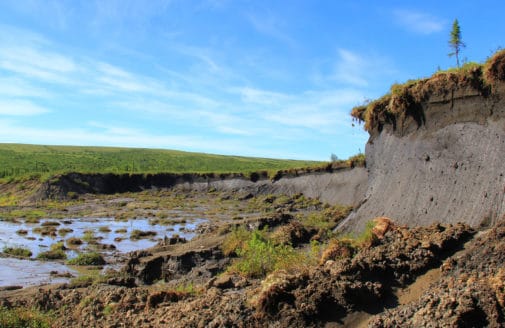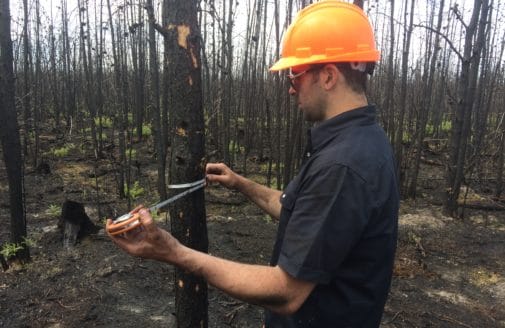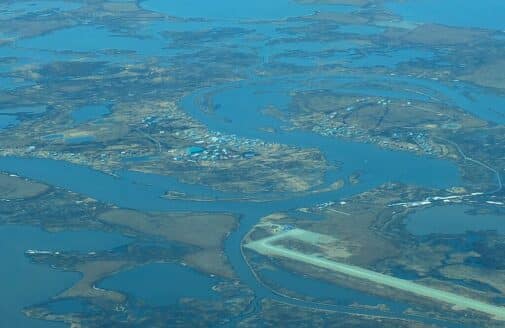Black spruce are losing their legacy to fire
Although evolved to thrive in fire-disturbed environments, a recent study shows more frequent fires are threatening black spruce resilience
Young, fast-growing poplar trees spring up underneath burnt black spruce trunks, out competing spruce seedlings.
photo by Jill Johnstone
For the past five to ten thousand years, black spruce have been as constant on the boreal landscape as the mountains themselves. But that constancy is changing as the climate warms.
A recent study published in the Proceedings of the National Academy of Sciences, led by Dr. Jennifer Baltzer, Canada Research Chair in Forests and Global Change at Wilfrid Laurier University, found that shifts in wildfire regimes are pushing black spruce forests to a tipping point, beyond which the iconic species may lose its place of dominance in boreal North America.
Synthesizing data from over 1500 fire-disturbed sites, the study showed black spruce’s ability to regenerate after fire dropped at 38% of sites and failed completely 18% of the time—numbers never before seen in a species evolved to thrive after fire.
The Stabilizing Feedback of Black Spruce
“They almost look like a Dr. Seuss tree.” says Dr. Brendan Rogers, an Associate Scientist at Woodwell and co-author on the PNAS study. He’s referring to the way black spruce are shaped—short branches that droop out of spindly trunks. Clusters of small dark purple cones cling to the very tops of the trees. Black spruce forests tend to be cool and shaded by the dense branches, and the forest floor is soft and springy.
“The experience of walking through these forests is very different from what most people are accustomed to. The forest floor is spongy, like a pillow or waterbed,” Dr. Rogers says. “It’s often very damp, too, because black spruce forests facilitate the growth of moss and lichen that retain moisture.”
However, these ground covers can also dry out quickly. Spruce have evolved alongside that moss and lichen to create a fire-prone environment. It only takes a few days or even hours of hot and dry weather for the porous mosses to lose their moisture, and the spruce are full of flammable branches and resin that fuel flames up into the tree’s crown.


Left: Seedlings growing out of mossy groundcover.
Right: Core of boreal forest soil with thick organic layers.
photos by Brendan Rogers
Black spruce need these fires to regenerate. Their cones open up in the heat and drop seeds onto the charred organic soil, which favors black spruce seedlings over other species. The organic soil layers built up by the moss are thick enough to present a challenge for most seedlings trying to put down roots, but black spruce seeds are uniquely designed to succeed.
Dr. Jill Johnstone, Affiliate Research Scientist at the University of Alaska Fairbanks, who also contributed to the PNAS study, compares it to a lottery system that black spruce have rigged for millennia.
“After fire, anything can happen,” says Johnstone. “But one way to make sure you win the lottery is to buy a lot of tickets. Black spruce has the most tickets. It has the most number of seeds that are the right size to get roots down into mineral soil, and so it tends to regenerate after fire.”
Potential competitors like white spruce, Dr. Johnstone says, don’t disperse very far from standing trees so they only get a few lottery tickets. Deciduous species like aspen or birch have seeds that are too small to work through the thick organic layers—their tickets are faulty. So the fire lottery tends to perpetuate black spruce’s dominance in what’s known as a “stabilizing feedback loop”.
Hotter, Dryer Conditions are Inhibiting Black Spruce Regeneration
That stable loop has begun to break down, however. Black spruce just aren’t re-establishing themselves as frequently after fire. The study examined the characteristics of different sites to better understand what might be hampering regeneration success.
Sites that failed to regenerate with black spruce were typically drier than normal. They also tended to have shorter intervals between successive fires. Black spruce stands have historically experienced the kinds of intense, stand-replacing fires that burn through everything only once per century. This long interval allows the trees to build up a healthy bank of cones to release seeds the next time they burn. More frequent, returning fires short-circuit the regeneration process.
Increased burning also strips away more of that thick organic soil layer that favors black spruce, revealing mineral soils underneath that level the playing field for other tree species. The more completely combusted those organic layers are, the more likely spruce are to have competition from jack pine, aspen, or birch. Loss of black spruce resilience was more common in Western North America, which aligns with the fact that drier sites are more likely to lose their black spruce.
“Basically, the drier the system is, the more vulnerable it is to fire,” Dr. Baltzer says. “And these are the parts of the landscape that are also more likely to change in terms of forest composition, or shift to a non-forested state after fire. If climate change is pushing these systems to an ever drier state, these tipping points are more likely to be reached.”
For Dr. Rogers, it also highlights the real possibility of losing black spruce across much of boreal North America as the region warms.
“This is evidence that black spruce is losing its dominant grip on boreal North America,” Rogers says. “It’s happening now and it’s probably going to get worse.”
Losing Black Spruce Could Accelerate Permafrost Thaw
Landscape-wide ecological shifts from black spruce to other species will have complicated, rippling impacts on the region.
Of most concern is the impact on permafrost. In many parts of the boreal, those mossy soil layers that promote black spruce also insulate permafrost, which stores large amounts of ancient carbon. Replacing the dark, shaded understory of a black spruce forest with a more open deciduous habitat that lacks mossy insulation could accelerate thaw. Thawing permafrost and associated emissions would accelerate a warming feedback loop that could push black spruce to its tipping point.
Widespread loss of black spruce also has implications for biodiversity, particularly caribou species that overwinter in the forest and feed on lichen. Both barren-ground and boreal caribou, important cultural species for northern communities, are already in decline across the continent and would suffer more losses if the ecosystem shifts away from the black spruce-lichen forests that provide food and refuge.

Scientists head into a burned black spruce site to take samples.
photo by Brendan Rogers
Dr. Johnstone did point out some potential for black spruce to recover, even if initial regeneration post-fire is dominated by other species. Slower growing, but longer lived, conifers can often grow in the shade of pioneer deciduous species and take over when they begin to die off—but this requires longer intervals between fires for the spruce to reach maturity. There is also the possibility that more deciduous trees, which are naturally less flammable than conifers, could help plateau increasing fires on the landscape.
But both these hopes, Dr. Baltzer says, are dependent on getting warming into check, because deciduous or conifer, “if it’s hot enough, and the fuel is dry enough, it will burn.”
Latest in Arctic
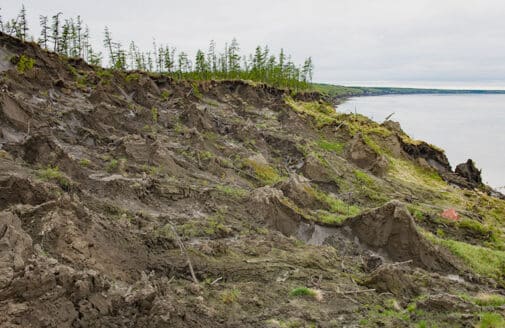
- In The News
Alaska permafrost put at risk by climate change
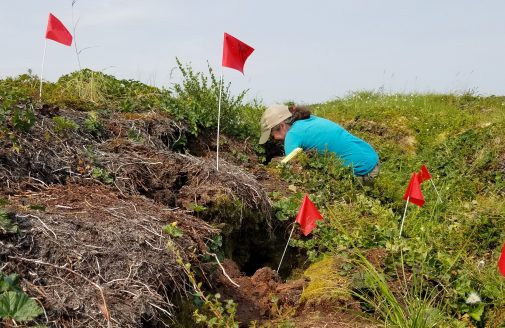
- In The News




